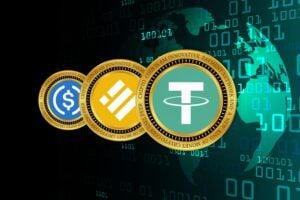Non-fungible tokens (NFTs) have conquered the digital space in recent months and, at the latest with the Beeple auction, have entered the mainstream of the crypto and financial scene. Although average prices have fallen since the NFT hype in the spring, the current market volume shows how quickly digital art has developed into a billion-dollar asset class: In the first half of 2021, NFT sales reached $2.5 billion.
The hype was reignited a few days ago when a twelve-year-old sold his digital collection of pixel whale images for 300,000. NFTs from many big names and entrepreneurs have fueled hundreds of millions of dollars for online transactions. But why is so much money being spent on things that only exist virtually? Allow us to break down the NFT myth for you and find out what to look out for as a potential investor.
Crypto Assets Continue to Evolve and Become more Sophisticated
An NFT is a digital asset or unit of data stored in a digital ledger called a blockchain. Accordingly, NFTs are the digital version of real physical assets such as paintings, games, music albums or collectible sports cards. Anyone can monetize their skills and talent by selling their creations online as NFTs. These assets are bought and sold with cryptocurrencies because they are coded with similar software, which simplifies the transaction process.
Related: NFT hype continues: Visa buys CryptoPunk token
Cryptocurrencies and other crypto assets are evolving rapidly and becoming increasingly integrated into mainstream financial markets and conversations. Although the majority of investor discussions are still related to Bitcoin and other top cryptocurrencies, the blockchain and crypto asset space has now also developed in other directions.
Whether it’s the increasing use of smart contracts for various business applications, decentralized finance (DeFi), central bank digital currencies (CBDCs) or NFTs, the underlying trend is clear; crypto assets continue to evolve and become more sophisticated. While there may be many practical applications for NFTs in the future, they are mainly used for digital art these days.
How Do NFTs Differ from other Crypto Assets?
But how do these crypto assets differ from other crypto forms, especially when it comes to adoption and implementation in companies? Unlike most digital creations, which are available in multiple copies, non-fungible tokens (NFTs) are unique and have a unique identification code.
Similar to fingerprints, no two NFTs are identical. This makes it difficult to create and distribute fake NFTs. So they cannot be exchanged directly with each other like cryptocurrencies or traditional fiat currencies. When people buy NFTs, they receive certificates that are secured with blockchain technology.
While each individual crypto asset works differently and NFTs are no exception to this rule, there are several general trends to consider.
- Unique and distinctive: As the name suggests, each individual NFT is a unique asset that differs from other existing crypto forms. Be it decentralized crypto like Bitcoin, privately issued and managed stablecoins or even the potential for a CBDC – each of these crypto assets is inherently fungible and can be exchanged for equivalent items.
Non-fungible tokens, on the other hand, cannot be freely exchanged for each other, as each NFT represents a unique, cryptographically secured piece of data. This also means that, unlike other cryptocurrencies, NFTs are usually not used as a medium of exchange and are not designed for such use.
Digital collectibles are in demand: What’s behind it? Hype or bubble?
- Immutable: Another important element of an NFT is that it is immutable, which means that the respective token cannot be changed or supplemented in the future, which gives creators the power to determine the conditions of each individual NFT. This allows, for example, the creator of an NFT artwork to automatically receive license fees or shares of the sales price each time his work is resold, creating a secondary market.
- Tax implications: As with any other form of crypto asset, the tax scenarios surrounding NFTs are complicated and subject to rules that can – and most likely will – change. The current tax situation for crypto assets is that every time a crypto asset changes hands, an income tax event is generated. Even if there is no profit that leads to a tax liability, there are still the reporting and compliance issues, which makes the use of NFTs for transaction purposes less attractive.
- Monetization: The original concept of an NFT was primarily captured and used by artists and other content creators to protect various types of intellectual property. Artists, entertainers, musicians and other creators of information may have been the first groups to recognize the potential of NFTs, but they are certainly not the last. Soon, NFT investors and owners also recognized the opportunity to further monetize these assets. Apart from benefiting from the price increase, there is also the possibility for some investors to trade NFTs and thus generate income streams.
Edward Snowden sells his portrait as an NFT for $5.5 million
- More than art: The NFT sector has long outgrown the mere securing of works of art and other forms of art-related content. From deeds and mortgages to commodities and rare materials such as diamonds to personally identifiable information (PII), everything is positively influenced by the growing size of the NFT sector. The protection and security of data is an essential component of any successful business or economic sector, and NFTs represent a quantifiable step towards making the security of blockchain more understandable and accessible to individuals and organizations across the economy.
As with any new and creative financial instrument and crypto asset, those individuals and companies in particular who are proactive and forward-thinking will benefit the most. NFTs are here to stay and understanding these crypto assets is soon shifting from a nice-to-have to a must-have.
Buying NFTs – Here’s How
You can buy, sell, trade and create NFTs on online exchanges or marketplaces. The creator or current owner can sell it at a fixed price or auction it off. The best-known NFT platforms include: Foundation, Nifty Gateway, OpenSea, Rarible, SuperRare, with the crypto exchange Binance recently launching its own NFT marketplace.
The registration process may vary depending on the marketplace. Generally, you buy NFTs with a cryptocurrency such as Ethereum, although the price may also be stated in dollars. Depending on the marketplace, different fees may apply to each transaction.
The Dark Side of NFTs
NFTs can be seen in part as highly speculative assets. Some people may have made thousands or millions of dollars selling NFTs. Others may spend a lot of money on a digital asset that ends up being worthless. If the hype subsides and NFTs become just another digital collectible, it will be more difficult to make profits from a seller’s perspective, as everyone else in the market will also be trying to make profits.
If you are considering buying an NFT as an investment, you should know that there is no guarantee of an increase in value. While some NFTs sell for thousands or millions of dollars, others may remain or become worthless.
Related: Binance launches its own NFT marketplace
However, the high-priced NFT craze also attracts fraudsters, so investors should be on their guard. Finally, it should also be mentioned that securing NFTs on the blockchain naturally also consumes electricity, as they use the same blockchain technology as cryptocurrencies, which generates high greenhouse gas emissions. However, energy consumption is also becoming increasingly important in the crypto industry, which is why environmentally friendly crypto projects are becoming more prominent.
Tokenization of Physical Objects and the Future of NFTs
While NFTs have so far mainly been used in connection with digital assets, they can practically tokenize just about anything. This means that they could theoretically also replace contracts, deeds and ownership certificates. The tokenization of physical objects has not yet developed as far as the tokenization of digital objects, but there have been some limited cases in which NFTs have also tokenized physical objects.
It is quite possible that NFTs will also change other markets, including perhaps the music industry, the fashion industry, the real estate market, the diamond market or any other market where scarcity is a relevant factor.
Non-fungible tokens also open up new possibilities, such as NFTs as collateral for loans. NFTs now also make it easier for creators and buyers to have fractional ownership of the respective workpieces and enable investors to own only part of an NFT without having to buy the whole thing. At the very least, it seems clear that NFTs represent a new frontier for technology law and their current applications are just the tip of the iceberg.


